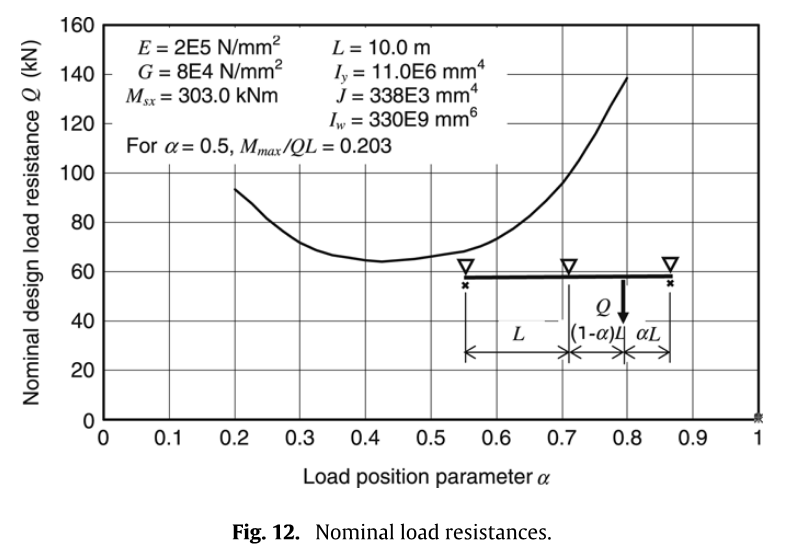SeanMD
Structural
- Jun 17, 2005
- 53
I am having trouble determining the proper unbraced length to use for a bottom running crane runway.
I am looking at basically two types: continuous runway with top flange hanger supports at 25ft oc, and 50ft runways (2 span continuous) with top flange hanger supports at 25ft.
Runways are attached/hung from roof framing, and are not "braced" against rotation. Only the top flange is braced, and the web is open to allow the crane bridge truck wheels to pass. Bottom flange is not braced.
Obvious problem is reverse curvature bending, the bottom flange is in compression at the hanger locations.
The way I understand it, LTB brace points really need to prevent rotation to be effective. In this system I have a lateral restraint at the tension/top flange at the hanger location from the roof framing, which is not a brace as it does nothing to keep the beam from rolling.
This is a condition where the trolley wheels at the bottom flange (pulling down on the bottom of the beam) and the hanger loads (pulling up on the top of the beam) will tend to offer resistance to beam rotation, they will help to keep the beam straight.
A Cb modifier of 1.4 could be justified to increase the Cb factor for bottom flange loading, etc, but to apply a Cb factor at all you need to know the unbraced length.
I want to say it is 25ft, but am not sure. A colleague suggested considering inflection points, and I know that practice is no longer approved. Interestingly the 2017 AISC web webinar "Design of Underhung Hoist and Crane Girders" suggested: Must consider LTB of girder bottom flange at supports. Treat
similar as a cantilevered condition. Must locate inflection
point
Obviously the system works, as it is very common in industrial facilities. Can anyone point me to a reference on how to determine the correct unbraced length?
I am looking at basically two types: continuous runway with top flange hanger supports at 25ft oc, and 50ft runways (2 span continuous) with top flange hanger supports at 25ft.
Runways are attached/hung from roof framing, and are not "braced" against rotation. Only the top flange is braced, and the web is open to allow the crane bridge truck wheels to pass. Bottom flange is not braced.
Obvious problem is reverse curvature bending, the bottom flange is in compression at the hanger locations.
The way I understand it, LTB brace points really need to prevent rotation to be effective. In this system I have a lateral restraint at the tension/top flange at the hanger location from the roof framing, which is not a brace as it does nothing to keep the beam from rolling.
This is a condition where the trolley wheels at the bottom flange (pulling down on the bottom of the beam) and the hanger loads (pulling up on the top of the beam) will tend to offer resistance to beam rotation, they will help to keep the beam straight.
A Cb modifier of 1.4 could be justified to increase the Cb factor for bottom flange loading, etc, but to apply a Cb factor at all you need to know the unbraced length.
I want to say it is 25ft, but am not sure. A colleague suggested considering inflection points, and I know that practice is no longer approved. Interestingly the 2017 AISC web webinar "Design of Underhung Hoist and Crane Girders" suggested: Must consider LTB of girder bottom flange at supports. Treat
similar as a cantilevered condition. Must locate inflection
point
Obviously the system works, as it is very common in industrial facilities. Can anyone point me to a reference on how to determine the correct unbraced length?



![[idea] [idea] [idea]](/data/assets/smilies/idea.gif)
![[r2d2] [r2d2] [r2d2]](/data/assets/smilies/r2d2.gif)